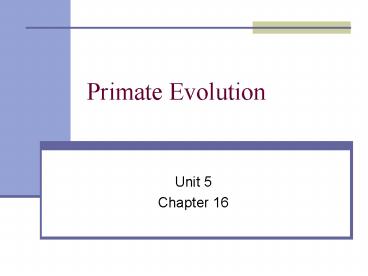Primate Evolution - PowerPoint PPT Presentation
1 / 30
Title:
Primate Evolution
Description:
Scientists believed that Old World and New World monkey shared a common anthropoid ancestor. From DNA evidence, scientists believe this to be the order of ape ... – PowerPoint PPT presentation
Number of Views:313
Avg rating:3.0/5.0
Title: Primate Evolution
1
Primate Evolution
- Unit 5
- Chapter 16
2
Primates (a group of mammals)
- majority live in trees (arboreal)
- include lemurs, monkeys, apes, and humans
3
Primate characteristics
- Rounded heads
- Flattened faces
- Opposable thumb
- Binocular vision
- Flexible joints
- Full arm motion
- Some with prehensile tails
- Large brains
4
Opposable thumb
- a thumb that can cross the palm to meet the other
fingertips - Adaptation gripping object
5
Groups of primates
ancestral primates
Tarsiers and anthropoids
lemurs and ayes-ayes
Lemur Tarsier
6
Lemurs and ayes-ayes
- Large eyes
- Nocturnal
- Habitat tropical rain forests
- Oldest found fossils 50-55 MYO
7
Tarsiers and anthropoids
- Larger brains
- More upright posture
- Anthropoids include humans, apes, and monkeys.
- Humans and apes are in a group called hominoids.
- Monkeys are divided into two groups Old World
and New World.
8
New World monkeys
- Habitat rainforests of Central and South America
- Prehensile tail able to grasp and hold with this
fifth limb
Squirrel monkey
9
Old World monkeys
- Larger than New World monkeys
- Tails that are not prehensile
- Appear superficially to be like hominoid apes
except that apes lack tails. - Habitat diverse, including African savanna and
Japanese mountains
Mandril
10
Hominoid apes orangutans, gibbons, chimpanzees,
bonobos, and gorillas
- long, muscled forelimbs
- climbing in trees
- swinging from branches
- knuckle walking
Bonobo knuckle-walking
11
Hominoid apes
- May be arboreal but mostly spends time on the
ground - Defined social structure and behaviors (including
grooming)
12
Hominoid humans
- Even larger brain capacity than apes
- Upright stature
Note the differences in brain capacity of the
skulls left to right, ape, chimp, human
13
Where did hominoids come from?
- Scientists believed that Old World and New World
monkey shared a common anthropoid ancestor. - From DNA evidence, scientists believe this to be
the order of ape evolution gibbons, orangutans,
African apes, gorillas, and chimpanzees.
14
Comparing DNA of humans and chimps
- Humans and chimps share the greatest sequence of
DNA nucleotides. - This implies that humans and chimps are more
likely to share a recent ancestor. - This does not imply that humans descended from
chimps.
15
Human evolution
- Fossil and DNA evidence indicates that about 5 to
8 million years ago, an ancestral hominoid
diverged into two pathways chimps and humans. - Changes in food supply and climate favored those
hominoids that could forage for food on land
rather than in trees.
16
Characteristics for non-arboreal primates
- Bipedal using two legs for upright walking
- Upright posture facilitates primate to see
farther - Bipedal hominoid primates are called hominids and
include humans.
Bipedalism is a more adapted behavior than
knuckle-walking apes.
17
How do scientists know that early hominids walked
upright?
- The opening in the skull where the spinal cord
attaches shows how the head and spine are
positioned. - Anthropologist Raymond Dart discovered an early
skull that appeared ape-like but had the spinal
attachment position like modern humans.
Notice how the angle of the arrow changes with
the human skull as compared to the ape and chimp.
18
Australopithecus africanus
- The skull that Dart discovered was named A.
africanus. - Estimated age 2.5 to 2.8 MYO
- These primates are called australopithecines
(apelike and humanlike).
19
1974 discovered australopithecine Lucy
Australopithecus afarensis, dated about 2-3 MYO,
shows pelvis structures that would indicate
bipedalism.
20
Comparing skulls and pelvic bones
Chimps Early hominid Modern
human
Similar brain case size between these two
Shorter and wider pelvic bones indicate
bipedalism.
21
Australopithecine extinction
- Fossil records indicate a disappearance about
2.0-2.5 MYA. - Hominids more like modern humans with larger
brain cases may have evolved next.
In 1964, Louis and Mary Leakey discovered skulls
more like modern humans in Tanzania and named
this group Homo.
22
Homo habilis
- handy man
- Ancient stone tools found near the fossils of H.
habilis - Estimated age 1.5-2.5 MYO
Examples of tools that H. habilis may have used
23
Homo erectus may have evolved from H. habilis.
24
H. erectus characteristics
- Larger brain than H. habilis
- More human-like face
25
H. erectus
- Stone hand axe were found near H. erectus
fossils, indicating they hunted. - Hearths with charred bones found in H. erectus
caves indicate that they may have used fire.
26
H. erectus migration
- About 1 MYA, H. erectus migrated throughout
Africa, Asia, and Europe. - They became extinct between 130,000 and 300,000
years ago. - This is about the time that Homo sapiens fossils
appear in the fossil record (100,000-500,000 YA).
27
Neanderthals Homo group
- 35,000-100,000 YA in Europe, Asia, and Middle
East - Larger brain cases than H. erectus
- Prominent nose
- Thick bones
- May be a sister species to modern humans (not
direct ancestor) - Lived about the same time as Cro-Magnon
28
Cro-Magnon early humans
- 35,000-40,000 YA
- Same height, skull structure, tooth structure,
and brain size as modern humans - Toolmakers and artists
- Language
29
Possible appearance of Cro-Magnon
30
Early humans crossing land bridge
- 12,000 years ago, evidence shows that they
crossed a land bridge into North America. - They built settlements and domesticated animals.
Modern coastline
Ancient coastline
Ice sheets 21,000 yrs ago
Ice sheets 12,000 yrs ago
Possible migration route































